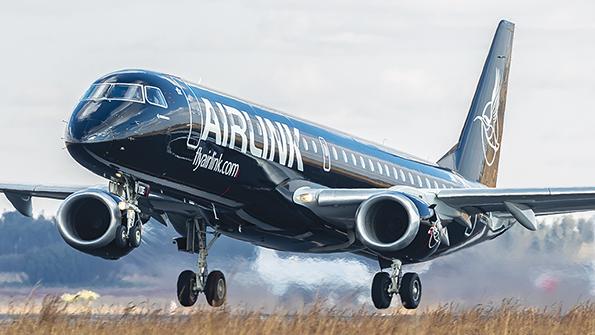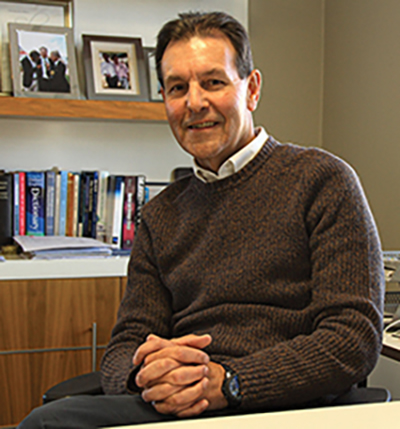
South African regional carrier Airlink has been through a storm and has come out thriving. In late 2019, Airlink’s longstanding franchise partnership with South African Airways (SAA) came to an abrupt halt; then COVID struck. Despite three-and-a-half years of hardship, Airlink has rapidly expanded to become a South African market leader, operating more than double the capacity of SAA.
You have led Airlink since its launch in 1992. What are the turning points that defined Airlink? We became a full-fledged franchisee of SAA in 1997. That enabled Airlink to expand to destinations that were never previously served under the SAA brand, and this endorsed Airlink. At that point in time, SAA was a revered and formidable global brand. The biggest setback was when SAA went into business rescue in December 2019, owing Airlink a fortune of money. That became one of the watershed moments that defined us. We had no choice but to jettison the relationship with SAA and become totally independent.
Did you see that coming? SAA’s financial issues dated back many years, probably to 2012. We were increasingly concerned about their sustainability. About three years before SAA went into business rescue, around 2016, we decided to source and implement a booking system, independent from SAA. It was fortuitous that we took that strategic decision despite the fact that it cost us a fortune. Once we had called the default and jettisoned the relationship with SAA, we were already in the position to be able to switch on our booking system. These things don’t happen overnight, and especially not a booking system which aligns with the global distribution systems. From 1997, all of our inventory had been distributed through SAA. We had become a full-fledged dependent. One of the lessons we learned was, do you really want to be dependent on another airline? And the answer is no.

COVID gave you some thinking time. What decisions did you make? We recognized that we needed to conjure up a strategy that would enable us to continue the business in an environment that we didn’t understand. We didn’t make a single job redundant. We used the COVID lockdown as an opportunity to re-engineer the business, to start with a clean sheet and ask, ‘Who are we?’ One of the things we recognized was the strength in our network and also the arsenal of traffic rights that we had, some of which we hadn’t had the opportunity to explore because of our previous relationship with SAA. We became uninhibited and unshackled. We could do whatever we wanted.
Several southern African carriers, including SAA, SA Express, Mango and Air Namibia, remained grounded after COVID. How did you capitalize on that? We had traffic rights for Windhoek, [Namibia], but we were not a designated carrier, so we forced our authority to designate us. We became the only service provider between Namibia and the rest of the world for a period of time. There were many of those opportunities that we saw. We built a business based on Airlink integrity, and we’ve established ourselves as a robust carrier. We’ve returned to profitability and rebuilt some of the equity that we lost through the SAA business rescue and keeping the business alive through COVID. On reflection, I think that Airlink is in a far better position now than we ever have been, having capitalized on all these opportunities. We’ve got more than 57 routes. Using 2019 as a baseline, we’ve increased our frequencies by 35%. We’ve increased our seats in the market by 83%, and we’ve increased our turnover by approximately 94%. So, we’ve doubled the size of business.
What comes next? We know that we’ve got to increase our presence on the trunk markets, but I think where we are most relevant is from South Africa and into the SADC region [the Southern African Development Community comprises 16 countries]. We’ve got over 60 Embraer regional jets. We have enough ERJs, but we’ve committed to several more E-Jets for delivery this year and early next year. We are mindful that, if we want to continue growing our presence on the trunk routes where we compete against the LCCs, the E-Jet is not the perfect aircraft from a cost perspective. We recognize that at some point in time we need to take the leap into narrowbody types, such as the Airbus A320 or the Boeing 737-800, but we are not ready to take that plunge. We are cautious about jumping into narrowbodies too quickly. The trunk routes are already very close to saturation, if not oversupplied.
In September 2022, you took a 40% stake in FlyNamibia, which has become an Airlink franchise carrier. Are you looking to form other equity/franchise partnerships? We’ve learned a lot about franchise relationships—we have 27 years of expertise—and we see a lot of sense in talking to smaller airlines that would struggle to gain critical mass, like FlyNamibia. There are many of them. We see the FlyNamibia model as being repeatable and scalable, so we could clone that model elsewhere within the region. Our immediate aspirations are not ‘pan-African,’ but they are certainly pan-regional. That model could be repeated in Botswana, Zimbabwe, Mozambique, Zambia and elsewhere. We’re not in a rush. This is not a race and it’s not about market share.
What wider shifts have shaped the South African market? The market has changed significantly, and the change isn’t just because of COVID. I think it went into an era of wholesale change just before the 2010 World Cup in South Africa. Prior to 2010, SAA had to make a call on which one of the global alliances it would join, and it joined the Star Alliance. For me, that became the watershed event that changed things for SAA. It became more focused on the Star Alliance and less focused on its source markets throughout the rest of the world. The soccer World Cup changed access to South Africa, especially for Emirates at Johannesburg and Cape Town in particular. Then Middle Eastern hub airlines, like Emirates, Qatar, Etihad and others, started making use of smaller-gauge aircraft to fly [directly] into smaller [African] destinations, so their networks and their footprints within Africa became prominent. Prior to that, traffic would find its way to one of the key hubs in Africa. They [passengers] suddenly started finding their way through hubs in the Middle East, Turkey and Addis Ababa. I think that changed the landscape completely for SAA.
What lessons have you taken away? There isn’t one carrier, or one alliance of carriers, that can comprehensively address every one of the source markets that are important to our network of destinations. One of our strategies is to be agnostic. We have a relationship with all of the global alliances, the mega-alliances, and we need to keep it that way, for the simple reason that we need to access all of the source markets. We can’t alienate ourselves from any of them. That will remain our strategy, certainly for now. We’ve got 34 commercial relationships with airlines from all over the world, like Air France-KLM, British Airways, Virgin, Delta, American, United, all the Middle Eastern airlines, Turkish, Ethiopian, Cathay, Qantas, etc. and five very strong codeshare relationships, which still have to develop, but they’re there.
